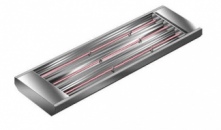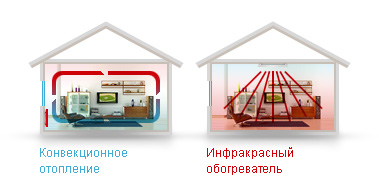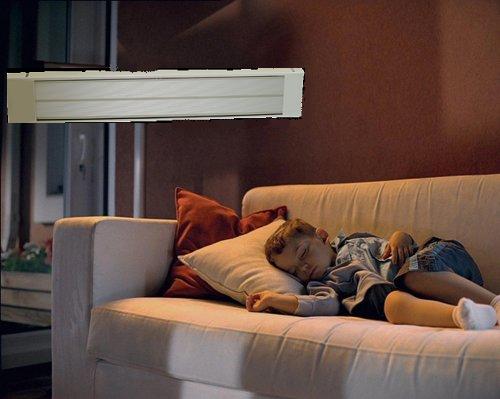The advantages of infrared heaters

The advantages of infrared heaters

An infrared heater can be considered any heated body that gives off heat to the environment mainly by radiation. The thermal energy emitted by the heater is absorbed by surrounding surfaces, such as floors, walls, furniture, etc., heating them.
In turn, they give off heat to the air. The thermal radiation of infrared heaters, similar to ordinary light, is not absorbed by air, so all the energy from the device without loss reaches the heated surfaces and people in the zone of its operation.
Thus, the use of infrared heaters leads to lower energy consumption and lower heating costs compared to traditional heating methods.
The benefits of infrared heating
1. Infrared heaters save energy
-
When using infrared heaters, we can afford to lower the temperature by several degrees, but the “felt” temperature will remain the same, since the decrease in air temperature will be compensated by the “radiation” additive. A person will feel a higher temperature due to direct absorption of energy from the device. Lowering the temperature by 1 degree gives 5% energy savings!
-
Infrared heaters are the only type of heating devices that allows for zone or spot heating.
In the case of zone heating in different parts of the room, modes with different temperatures can be supported. For example, if workplaces are located at a considerable distance from each other, the room as a whole should not have the same temperature. Even in terms of comfort, different working situations involve different temperatures.
-
The lower cost of electricity at night can be used for heat storage by building structures and equipment. Heating during these hours does not lead to an overload of the mains during periods of critical load. The amount of interference in the mains can also be reduced.
-
When using traditional convective heating systems, we are faced with the fact that the air temperature varies in height - the system has a high temperature gradient. Infrared heaters allow avoiding such an irrational temperature distribution, since they do not heat the air, but transfer heat to the surfaces of solid objects. In this case, there is no excessive heating of the air, the temperature is equalized between the floor and the ceiling, which allows for 15-40% energy saving.
The temperature gradient (° C / m - increase in temperature per unit height) is very low when using infrared devices: approximately 0.3 ° C / m. When heated with warm air or convectors, significantly higher temperature gradients arise - 2.5 and 1.7 ° C / m - Glass is not "transparent" to the radiant flux, so there is no loss of radiant energy
 2. Infrared heaters increase comfort
2. Infrared heaters increase comfort
-
A person's stay in a zone with reduced thermal insulation (for example, next to a window) will cause discomfort. The infrared heaters installed in these zones will help compensate for heat loss and provide comfort.
-
The operation of infrared equipment does not cause air circulation in the room, which guarantees the absence of drafts. Devices installed in such an area block the movement of cold air and provide a more comfortable stay of a person near the window due to their direct absorption of thermal energy.
-
Items located in the range of infrared heaters will have a temperature slightly higher than the temperature of the air. Contact with them will not cause discomfort in a person.
-
Modern electronics, controlling the operation of infrared heaters in a pulsed mode, maintains the temperature of devices at a constant level due to the thermal inertia of the heating surface. Precise adjustment avoids the release of excess power and provides a special "softness" of the heating system.
-
Due to the reduced air turbulence in the room, the turbulence of dusty particles is limited, therefore, the risk of the possible occurrence of various diseases is reduced: asthma, inflammation of the mucous membranes, etc.
- Due to the increase in wall temperature, the possibility of condensation is reduced; humidity does not change significantly
3. Infrared heaters practical
-
Arranging traditional heating systems often requires significant capital investments (laying highways, pipe wiring, etc.) and takes a lot of time. To install infrared heaters you will need a minimum of time and money. In case of moving, you can easily remove and take the devices with you to install them in a new place.
-
The installation of infrared heaters on the ceiling or on the suspension allows you to keep the walls and floor free, which increases the useful volume of the room.
-
Infrared heaters provide accelerated, in comparison with traditional systems, heating of the room, as they transfer all the energy to the area where people are. This quality allows you to lower the temperature at night, weekends and holidays, which significantly reduces energy consumption.
-
Infrared devices are compatible with any ventilation systems, since their operation does not lead to the circulation of air flows that can affect the functioning of ventilation systems.
-
Where the capacity of the existing heating system is insufficient, infrared heaters will become a simple and inexpensive solution as an additional heat source.
-
Infrared heaters are the only heating method in open areas and in rooms with poor thermal insulation. The range of their application is extremely wide: from heating spectators in stadiums and visitors to open cafes to using them as de-icing systems on flights of stairs and entry ramps.
-
Infrared heaters are used where, according to technology requirements, it is necessary to maintain an elevated surface temperature. For example, with accelerated hardening of reinforced concrete parts or drying of painted parts.
How to choose an infrared heater
- In rooms with a small ceiling height, as a rule, long-wave infrared heaters are used, which give good heat dissipation and provide a high degree of comfort.
- In rooms with high ceilings, in open areas and in the case of local heating, it is preferable to choose outdoor medium-wave heaters that give a more intense and concentrated flow.
- For regions with a low cost of liquid fuel (diesel fuel, propane), the use of infrared heaters operating on liquefied gas and diesel fuel is optimal.
Are infrared heaters dangerous?
 Infrared heaters are absolutely safe. Infrared radiation is a natural type of heating. The most famous infrared heater is the sun..
Infrared heaters are absolutely safe. Infrared radiation is a natural type of heating. The most famous infrared heater is the sun..
The difference from traditional heaters is that, first of all, it is not air that is heated, but an object located in the device’s coverage area (floors, walls, furniture, people). Infrared rays are able to travel long distances with minimal energy loss. Therefore, infrared heaters are especially effective for heating homes, rooms with large ceilings (stadiums, industrial premises), local heating (workplaces in large rooms), heating outdoor areas (stadiums, open cafes).
